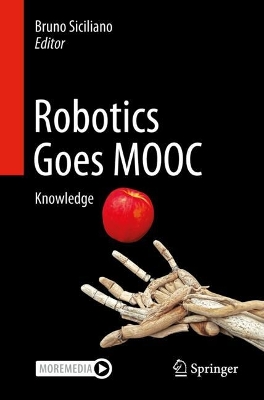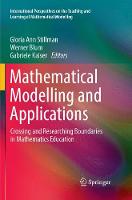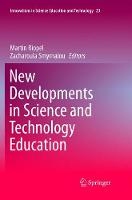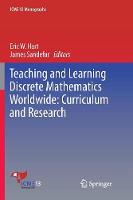Mathematics and Technology
 -15%
portes grátis
-15%
portes grátis
Mathematics and Technology
A C.I.E.A.E.M. Sourcebook
Gellert, Uwe; Aldon, Gilles; Hitt, Fernando; Bazzini, Luciana
Springer International Publishing AG
07/2018
693
Mole
Inglês
9783319846347
15 a 20 dias
1062
Descrição não disponível.
Introduction, Fernando Hitt.- Part 1 Technology, a Tool for Teaching and Learning Mathematics: A. Teaching.- Early child spatial development: A teaching experiment with programmable robots, Cristina Sabena.- Mediation of technological resources in lessons on polyhedra: Analysis of two teaching actions, Nielce Meneguelo Lobo da Costa, Maria Celia Pimentel de Carvalho, and Tania Maria Mendonca Campos.- Task design in a paper and pencil and technological environment to promote inclusive learning: An example with polygonal numbers, Fernando Hitt, Mireille Saboya, and Carlos Cortes.- ICT and liminal performative space for Hyperbolic Geometry's teaching, Panagiota Kotarinou and Charoula Stathopoulou.- Improving the teaching of mathematics with the use of technology: A Commentary, Sixto Romero.- Part 2 Technology, a Tool for Teaching and Learning Mathematics: B. Learning.- Domains of manipulation in touchscreen devices and some didactic, cognitive and epistemological implications for improving geometric thinking, Marcelo Bairral, Ferdinando Arzarello, and Alexandre Assis.- Graphs in primary school: Playing with technology, Daniela Ferrarello.- Pocket calculators as an experimental milieu: Emblematic tasks and activities, Ruhal Floris.- The street lamp problem: Technologies and meaningful situations in class, Elisa Gentile and Monica Mattei.- A framework for failed proving processes in a Dynamic Geometry Environment, Madona Chartouny, Iman Osta, and Nawal Abou Raad.- Disclosing the "raemotionality" of a mathematics teacher using technology in her classroom activity, Marina De Simone.- Integrating arithmetic and algebra in a collaborative learning and computational environment using ACODESA, Fernando Hitt, Carlos Cortes, and Mireille Saboya.- L-system fractals as geometric patterns: A case study, Anna Alfieri.- Learning and technology? Technology and learning? A commentary, Peter Appelbaum.- Part 3: Communication and Information: A. Communication Inside and Outside the Classroom.- E-mathematics engineering for effective learning, Giovannina Albano.- Learning paths and teaching bridges: The emergent mathematics classroom within the open system of a globalised virtual social network, Andreas Moutsios-Rentzos, Francois Kalavasis, and Emmanouil Sofos.- E-collaborative forums as mediators when solving algebraic problems, M. Pilar Royo, Cesar Coll, and Joaquin Gimenez.- Part 4: Communication and Information: B. Information's Tools, to Inform Oneself and to Inform Others.- Problems promoting the devolution of the process of mathematisation: An example in number theory and a realistic fiction, Gilles Aldon, Viviane Durand-Guerrier, and Benoit Ray.- A classroom activity to work with real data and diverse strategies in order to build models with the help of the computer, Marta Ginovart.- Communication inside and outside the classroom: A commentary, Corinne Hahn.- Part 5: Technology and Teachers' Professional Development.- A study on statistical technological and pedagogical content knowledge on an innovative course on quantitative research methods, Ana Serrado Bayes, Maria Meletiou-Mavrotheris, and Efi Paparistodemou.- The professional development of mathematics teachers: Generality and specificity, Maria Polo.- Integration of digital technologies in mathematics teacher education: The reconstruction processes of previous trigonometrical knowledge, Nielce Meneguelo Lobo da Costa, Maria Elisa Esteves Lopes Galvao, and Maria Elisabette Brisola Brito Prado.- Formative assessment and technology: Reflections developed through the collaboration between teachers and researchers, Gilles Aldon, Annalisa Cusi, Francesca Morselli, Monica Panero, and Cristina Sabena.- Teaching intriguing geometric loci with DGS, Daniela Ferrarello, Maria Flavia Mammana, Mario Pennisi, and Eugenia Taranto.- Technology and teachers' professional development: A commentary, Gail E. FitzSimons.- Conclusion, Gilles Aldon.
Este título pertence ao(s) assunto(s) indicados(s). Para ver outros títulos clique no assunto desejado.
CIEAEM67;Collaborative learning;Digital technology;Educational technology;Game-based learning;ICT in mathematics education;Learning mathematics;Mathematics teacher education;Teaching mathematics;Virtual learning environments;learning and instruction
Introduction, Fernando Hitt.- Part 1 Technology, a Tool for Teaching and Learning Mathematics: A. Teaching.- Early child spatial development: A teaching experiment with programmable robots, Cristina Sabena.- Mediation of technological resources in lessons on polyhedra: Analysis of two teaching actions, Nielce Meneguelo Lobo da Costa, Maria Celia Pimentel de Carvalho, and Tania Maria Mendonca Campos.- Task design in a paper and pencil and technological environment to promote inclusive learning: An example with polygonal numbers, Fernando Hitt, Mireille Saboya, and Carlos Cortes.- ICT and liminal performative space for Hyperbolic Geometry's teaching, Panagiota Kotarinou and Charoula Stathopoulou.- Improving the teaching of mathematics with the use of technology: A Commentary, Sixto Romero.- Part 2 Technology, a Tool for Teaching and Learning Mathematics: B. Learning.- Domains of manipulation in touchscreen devices and some didactic, cognitive and epistemological implications for improving geometric thinking, Marcelo Bairral, Ferdinando Arzarello, and Alexandre Assis.- Graphs in primary school: Playing with technology, Daniela Ferrarello.- Pocket calculators as an experimental milieu: Emblematic tasks and activities, Ruhal Floris.- The street lamp problem: Technologies and meaningful situations in class, Elisa Gentile and Monica Mattei.- A framework for failed proving processes in a Dynamic Geometry Environment, Madona Chartouny, Iman Osta, and Nawal Abou Raad.- Disclosing the "raemotionality" of a mathematics teacher using technology in her classroom activity, Marina De Simone.- Integrating arithmetic and algebra in a collaborative learning and computational environment using ACODESA, Fernando Hitt, Carlos Cortes, and Mireille Saboya.- L-system fractals as geometric patterns: A case study, Anna Alfieri.- Learning and technology? Technology and learning? A commentary, Peter Appelbaum.- Part 3: Communication and Information: A. Communication Inside and Outside the Classroom.- E-mathematics engineering for effective learning, Giovannina Albano.- Learning paths and teaching bridges: The emergent mathematics classroom within the open system of a globalised virtual social network, Andreas Moutsios-Rentzos, Francois Kalavasis, and Emmanouil Sofos.- E-collaborative forums as mediators when solving algebraic problems, M. Pilar Royo, Cesar Coll, and Joaquin Gimenez.- Part 4: Communication and Information: B. Information's Tools, to Inform Oneself and to Inform Others.- Problems promoting the devolution of the process of mathematisation: An example in number theory and a realistic fiction, Gilles Aldon, Viviane Durand-Guerrier, and Benoit Ray.- A classroom activity to work with real data and diverse strategies in order to build models with the help of the computer, Marta Ginovart.- Communication inside and outside the classroom: A commentary, Corinne Hahn.- Part 5: Technology and Teachers' Professional Development.- A study on statistical technological and pedagogical content knowledge on an innovative course on quantitative research methods, Ana Serrado Bayes, Maria Meletiou-Mavrotheris, and Efi Paparistodemou.- The professional development of mathematics teachers: Generality and specificity, Maria Polo.- Integration of digital technologies in mathematics teacher education: The reconstruction processes of previous trigonometrical knowledge, Nielce Meneguelo Lobo da Costa, Maria Elisa Esteves Lopes Galvao, and Maria Elisabette Brisola Brito Prado.- Formative assessment and technology: Reflections developed through the collaboration between teachers and researchers, Gilles Aldon, Annalisa Cusi, Francesca Morselli, Monica Panero, and Cristina Sabena.- Teaching intriguing geometric loci with DGS, Daniela Ferrarello, Maria Flavia Mammana, Mario Pennisi, and Eugenia Taranto.- Technology and teachers' professional development: A commentary, Gail E. FitzSimons.- Conclusion, Gilles Aldon.
Este título pertence ao(s) assunto(s) indicados(s). Para ver outros títulos clique no assunto desejado.







